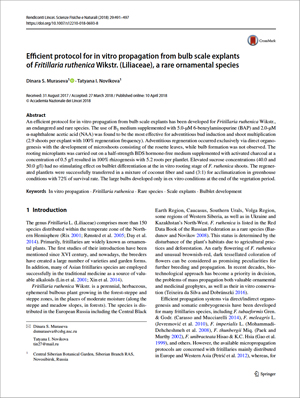NEWS 2018
Efficient protocol for in vitro propagation from bulb scale explants of Fritillaria ruthenica Wikstr. (Liliaceae), a rare ornamental species
Dinara S MURASEVA, Tatyana I NOVIKOVA
Rendiconti Lincei. Scienze Fisiche e Naturali, 29:491–497 (2018)
https://doi.org/10.1007/s12210-018-0693-8-9
Central Siberian Botanical Garden, Siberian Branch RAS, 630090 Novosibirsk, Russia
Abstract
An efficient protocol for in vitro propagation from bulb scale explants has been developed for Fritillaria ruthenica Wikstr., an endangered and rare species. The use of B5 medium supplemented with 5.0-μM 6-benzylaminopurine (BAP) and 2.0-μM α-naphthalene acetic acid (NAA) was found to be the most effective for adventitious bud induction and shoot multiplication (2.9 shoots per explant with 100% regeneration frequency). Adventitious regeneration occurred exclusively via direct organogenesis with the development of microshoots consisting of the rosette leaves, while bulb formation was not observed. The rooting microplants was carried out on a half-strength BDS hormone-free medium supplemented with activated charcoal at a concentration of 0.5 g/l resulted in 100% rhizogenesis with 5.2 roots per plantlet. Elevated sucrose concentrations (40.0 and 50.0 g/l) had no stimulating effect on bulblet differentiation at the in vitro rooting stage of F. ruthenica shoots. The regenerated plantlets were successfully transferred in a mixture of coconut fiber and sand (3:1) for acclimatization in greenhouse conditions with 72% of survival rate. The large bulbs developed only in ex vitro conditions at the end of the vegetation period.




